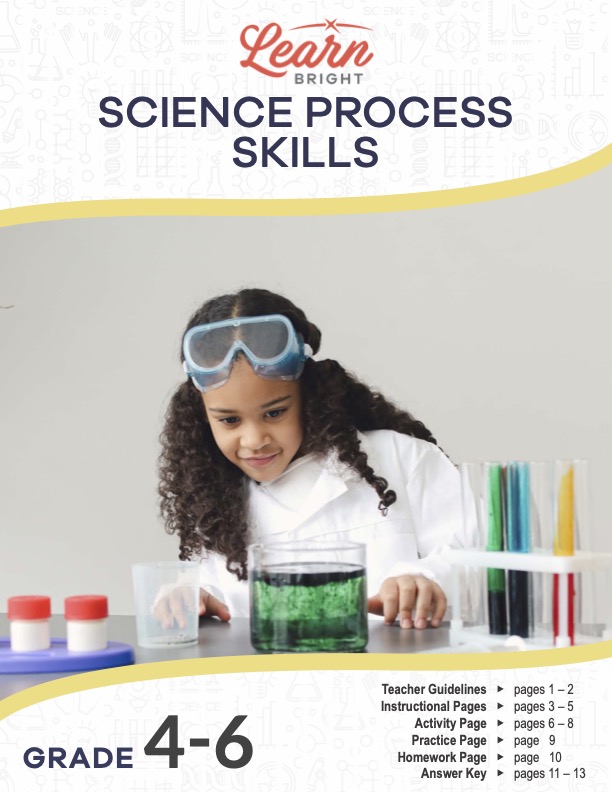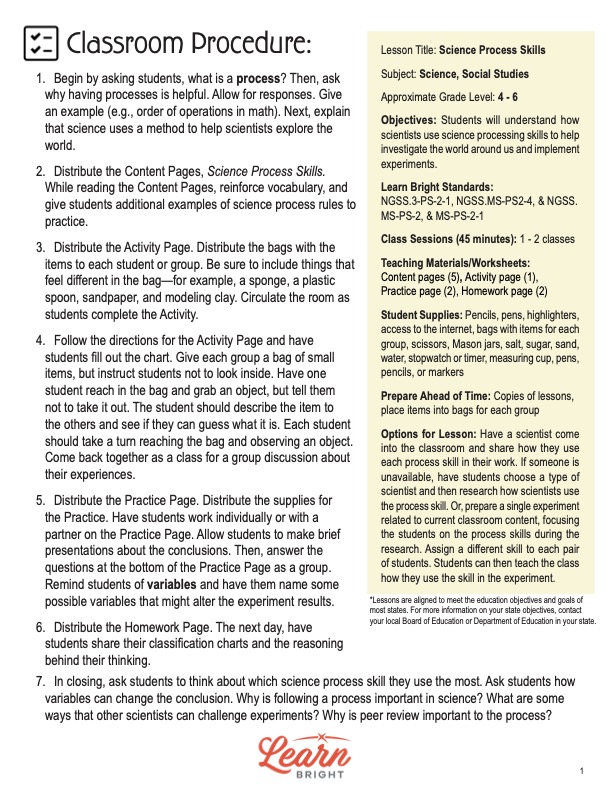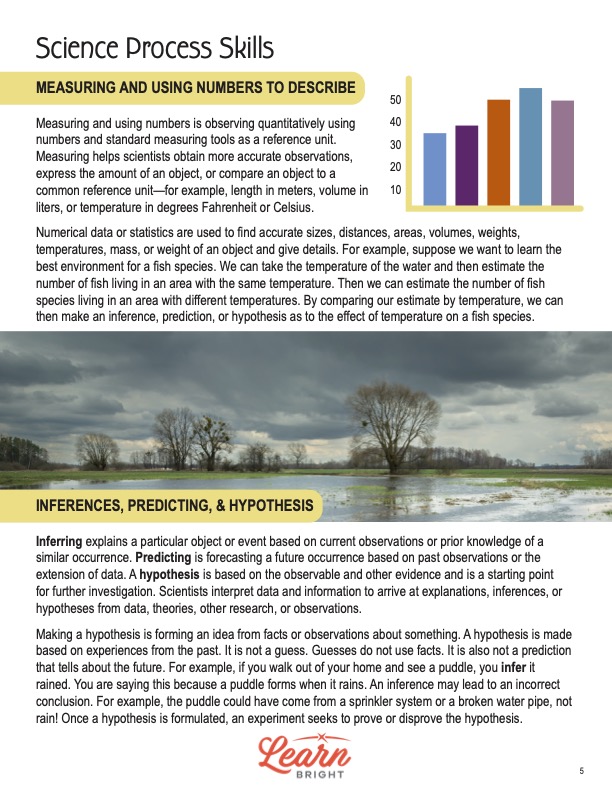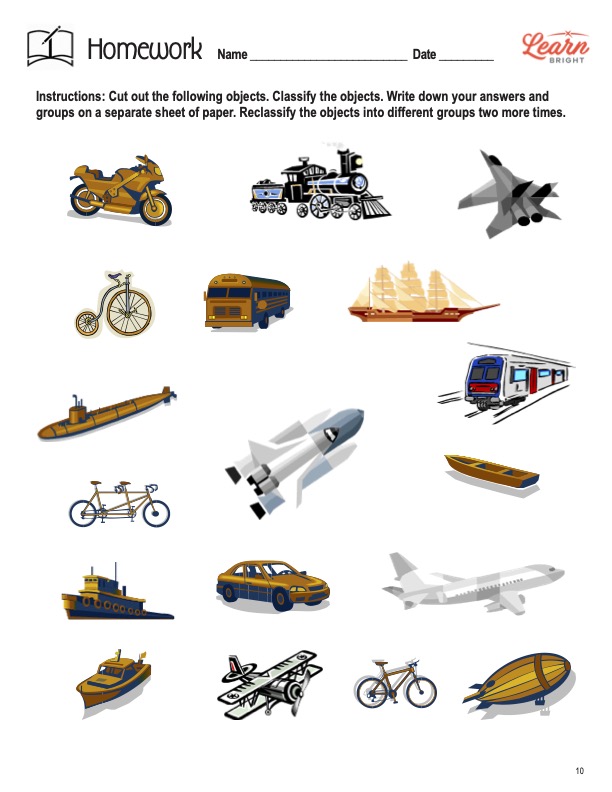Description
What our Science Process Skills lesson plan includes
Lesson Objectives and Overview: Science Process Skills teaches students how to define, identify, and use skills that relate to scientific experiments. Students will learn about skills such as observation, classification, prediction, and data interpretation. They will discover how to use many of these practices as they conduct experiments of their own. This lesson is for students in 4th grade, 5th grade, and 6th grade.
Classroom Procedure
Every lesson plan provides you with a classroom procedure page that outlines a step-by-step guide to follow. You do not have to follow the guide exactly. The guide helps you organize the lesson and details when to hand out worksheets. It also lists information in the yellow box that you might find useful. You will find the lesson objectives, state standards, and number of class sessions the lesson should take to complete in this area. In addition, it describes the supplies you will need as well as what and how you need to prepare beforehand. The activity in this lesson requires cups, spoons, salt, sugar, sand, and water. Make sure you provide supplies enough for every two students as they will work in pairs during the activity.
Options for Lesson
The “Options for Lesson” section of the classroom procedure page lists a number of suggestions for ideas and activities you could incorporate into the lesson. For the second and third activity worksheets, you could have students work in groups of three rather than in pairs. Another option is to prepare a single experiment related to current classroom content. Focus the students on the process skills during the research for that experiment. Alternatively, you could assign a different investigation to each pair of students. They can then go through the steps, use the process skills, and communicate and present their findings to the class. If the students have already done a science fair, another idea is to create a page with each process skill listed. Tell students to give examples of the times they used those skills while working on their science fair projects.
Teacher Notes
The paragraph on this page gives you a little more information on the lesson overall and describes what you may want to focus your teaching on. It suggests you teach this lesson near the beginning of the school year since students can then apply the skills they will learn about throughout the year. The blank lines are available for you to write out any thoughts or ideas you have as you prepare.
SCIENCE PROCESS SKILLS LESSON PLAN CONTENT PAGES
Science Process Skills
The Science Process Skills lesson plan has five content pages. Every worker has a set of tools to use for their job. For example, a carpenter uses a saw and hammer. A writer uses a printer and computer, or maybe a pencil and paper. A doctor uses a stethoscope, and a clerk at the store uses a cash register. Likewise, scientists have a set of tools called the science process skills.
These are the tools every kind of scientist uses to investigate the world around them. It doesn’t matter whether the scientist is a biologist, astronomer, oceanographer, zoologist, or chemist. They use science process skills to construct science concepts, discover new ideas, or prove or disprove theories. Just like the tools for other professions, these are the skills a scientist needs when performing their job duties.
Science process skills usually follow a specific order. Just like a carpenter will use the right tools to make furniture, a scientist will use the right skills to learn more about their research or experiment. Scientists also record their findings for every experiment, investigation, and observation. They keep accurate records so their peers can repeat the research and investigations. The lesson then explains six skills in detail.
Observation, Classification, and Measurements
Students will learn that the purpose of observation is to compile and gather as much information as possible about objects or phenomena. Scientists use observation to investigate an object using their five senses: sight, sound, taste, touch, and hearing. They observe by identifying characteristics, comparing things or events, and identifying changes.
Classifying is the process of grouping objects together according to specific characteristics for a purpose. For example, scientists classify when there are many items or information or when the information is not organized. Classification skills include detecting similarities and grouping objects based on a particular criterion.
Scientists measure things so that they can observe quantitatively using numbers and standard measuring tools as a reference unit. Measuring helps scientists obtain more accurate observations, express the amount of an object, or compare an object to a common reference unit. For example, length in meters, volume in liters, or temperature in degrees Fahrenheit or Celsius are all measurements. In addition, scientists use numerical data or statistics to find accurate sizes, distances, areas, volumes, weights, temperatures, mass, or weight of an object and give details.
Inferences, Conducting Experiments, and Communicating
To infer is to explain a particular object or event based on current observations or prior knowledge of a similar occurrence. Predicting is forecasting a future occurrence based on past observations or the extension of data. A hypothesis is based on the observable and other evidence and is a starting point for further investigation. Scientists interpret data and information to arrive at explanations, inferences, or hypotheses from data, theories, other research, or observations.
An experiment is a test we can perform to learn something or to discover if something works or is true. For example, scientists conduct experiments to test their hypotheses. They are very precise in the method and procedures of experiments and know that other scientists will check their results. They also know that in some cases, their conclusions can positively or negatively impact people’s lives.
Communicating involves several actions: a scientist must describe, record, and report experimental procedures and results to others. It includes oral, written, or mathematical forms. Scientists communicate effectively through specific vocabulary, graphs, and equations. Generally, they report their findings by publishing them in journals or presentations to other scientists. When other scientists review the report, this is called peer review.
SCIENCE PROCESS SKILLS LESSON PLAN WORKSHEETS
The Science Process Skills lesson plan includes five worksheets: three activity worksheets, a practice worksheet, and a homework assignment. Each one will help students solidify their grasp of the material they learned throughout the lesson. You can refer to the classroom procedure guidelines to know when to hand out each worksheet.
OBJECT GRAB ACTIVITY WORKSHEET
You can have students complete the activity in pairs or as a class instead of in groups if you want. Students will use their senses to guess what certain objects are. You will provide a bag of small objects to each group of students. Without taking any objects out of the bag, they will pick one at a time and describe it. The other students will use try to guess what the object is based on the description. When ready, the student will pull out the object, and the others will see whether or not they were correct. The worksheet provides a chart with space for several objects, so students can take turns pulling out objects.
SCIENCE PROCESS SKILLS PRACTICE WORKSHEET
The practice worksheet provides students the opportunity to conduct a simple experiment using the supplies you provide. Students will fill Mason jars with water and label each one salt, sugar, and sand. Then they will measure about a quarter of a cup of each substance using the measuring spoons.
For each jar, students will pour in the substance that matches the label. They will then see how long it takes each substance to dissolve. Next, students will fill out the table. They will write a hypothesis for each substance, record their observations, and formulate conclusions.
CLASSIFICATION HOMEWORK ASSIGNMENT
For the practice worksheet, students will cut out the pictures of various objects on the worksheet. They will classify the objects into groups and write them down on a separate sheet of paper. They will then reclassify the objects in a different way two more times. Again, they will write down how they grouped the objects for these two times.
Worksheet Answer Keys
There are answer keys for the practice and homework worksheets at the end of the document. Given the nature of these assignments, students’ answers will vary. The answer keys for provide sample answers in red that you can use for reference. If you choose to administer the lesson pages to your students via PDF, you will need to save a new file that omits these pages. Otherwise, you can simply print out the applicable pages and keep these as reference for yourself when grading assignments.









